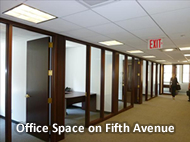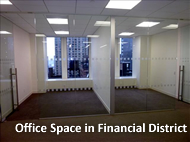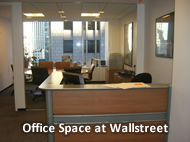"Detailed Leasing Information - An Overview of Leasing Office Space"
In essence, leasing an office space is a lot like entering into a business a partnership. Ideally, the parameters are set up to benefit both parties, with each party offering something and expecting something in return. When the partnership is successful, everyone does well. And when it doesn’t, there can be difficulty. Given the complicated nature of leasing real estate in New York City, it is critical that a lease agreement for commercial space is very carefully written. If not, both the landlord and the tenant are exposed to major potential problems.
Many lease agreements begin with the “Standard Form Office Space
Lease,” a generalized, standardized agreement commonly available.
Tenants need to know that while this type of lease agreement is prevalent,
it is almost always tilted toward the landlord’s interests. Landlords
often insert complicated legal language into standardized leases, tipping
the scales even more. Before entering into such an office rental agreement,
Prime Manhattan Realty insists upon thorough legal review. Of course,
landlords realize that educated tenants may attempt to sway the legal
language farther than they are comfortable with, which can lead to disagreement.
Differences of opinion about legal language are not the only source
of discord between tenants and potential landlords. The parties may
have different benchmarks for rent, construction, amenities and concessions.
Even the most sophisticated landlords and tenants may overlook, misunderstand
or under-negotiate significant issues.
This site has been crafted to serve as a resource to people who already
have a strong familiarity with office rentals in New York as well as
those that are just getting started. The processes involved in leasing
office property and commercial spaces are constantly evolving.
No matter how much you already know, you still need to be kept up-to-date.
This information will emphasize important issues and offer pragmatic
suggestions regarding the following:
- Understanding the process of leasing office space in New York City,
from top to bottom.
It's not brain surgery, just sound, sensible business practices. - Understanding important vocabulary words related to commercial property in New York.
- Determining the tenant's office space requirements regarding square footage.
- Analyzing the possible advantages and disadvantages of the tenant leasing or purchasing commercial space in Manhattan.
- Deriving a framework for comparison of different New York commercial properties based on market conditions.
- Compiling the important Request For Proposal (RFP) for Office Space.
- Landlord negotiations including legal review of lease clauses and other potentially volatile issues.
THE PROCESS - LEASING OFFICE SPACE AND COMMERCIAL REAL ESTATE
Landlords’ situations are fairly static. They offer particular benefits, provide services, and sell themselves to tenants. Because the lease process would never happen without tenants establishing their singular needs and desires, and those needs and desires are flexible, we will continue to view the situation from the tenants’ point of view. Landlords appreciate it when tenants do their homework. An educated tenant will be far more likely to enter into a long and fruitful lease agreement. Though we are viewing this process from one side, it should be acknowledged that a fair and balanced perspective will almost always lead to smooth negotiations between tenant and landlord.
The outline below addresses the key processes involved in a successful business relocation.
- 1) Specify and break down your Office Space Requirements
- Location. What part of the city is best for your business?
- Amenities/Services offered. What will you need your landlord to provide?
- Office Space - What are your current and future square footage needs?
- 2) Evaluate commercial space market conditions.
- 3) Choose ideal office space characteristics.
- Best location for your business needs.
- Preferred amenities/services.
- Landlord qualifications: reputation, past dealings with office space tenants.
- 4) Review key office space characteristics, visit prospective office space.
- 5) Create a proposal.
- Complete a Request for Proposal (RFP) detailing your needs.
- Disseminate the RFP to landlords of office buildings best suited to your business.
- Accept and analyze landlord’s proposals.
- Compare and discuss landlord offers. Compile a Comparative Office Space Lease Analysis.
- Assemble a report on landlord history, performance, rate of tenant satisfaction.
- Analyze data on building location and office space technical attributes.
- 6) Enter Negotiations.
- List commercial space negotiation requirements.
- Request advice from legal counsel.
- Landlord and Tenant discuss agreeable lease terms.
- Lease is signed.
- 7) Draft plans, apply for permits and begin construction of your new office space.
Select a delegation to search for your new commercial space.
In most instances, a business owner or office manager works directly with a commercial tenant broker to begin the discussion of and search for a new office space. When tenant’s needs are more complicated a greater number of representatives may be involved. Regardless, the entire delegation must be in constant communication, which will ensure the process remains cohesive from start to finish.
When smaller businesses relocate, the principal tends to assume responsibility
for all aspects of the move, which can be extremely challenging and
often overwhelming. Business owners will be best served if they can
share the responsibilities involved in the relocation process with trusted
employees. When others take care of the footwork and details, the principals
can devote more energy to oversight and management of the relocation,
ensuring a successful move.
Determine office space requirements.
Before taking the leap into the search for your business’ new home, be sure to have a comprehensive understanding of what you will need. Anyone directly involved in the office space search should participate in an in-depth discussion of what your new office space should offer.
The discussion should cover the following:
- Whether to renew the current lease, purchase the current space or relocate.
- Company goals for new commercial space.
- Prioritization of characteristics including location, image, services & amenities offered.
- Analysis of lease terms and price range.
- Any potential legal issues.
If your company requires significant square footage or a complicated office infrastructure, include an architectural consultant in the search process. The architectural consultant will work with you to determine the ideal physical requirements for your new office space.
Be sure to address the following:
- The effectiveness of your current space.
- The number and size of offices, common space, storage areas and any other spaces you want to include in your new office.
- Technological and computer requirements for your new space.
- Aesthetics: How you want the new space to look and feel.
When you have completed the discussion, create a summary of your architectural
needs. This will serve as an excellent guide for the remainder of the
relocation process. Combine the results of your basic and architectural
needs analyses into a master schedule to keep you on track.
Maintain a complete understanding of your square footage requirements.
You’ll want to know exactly how much space your business’ needs before surveying the market. Use the worksheet included with the how-to course to create an in-depth description of how you will use your new office space. Take your time in answering the questions and be sure to carefully consider each response. You’ll want to have the most accurate picture possible of what your business’ space needs are now and will be in the future.
The worksheet was created to help businesses of all sizes determine
their square footage requirements in detail, inspiring thoughtful analysis
of both shared spaces and private work areas. This analysis is then
converted into a final useable square footage requirement, with individual
discussions of how each separate component relates to the whole. When
the worksheet is completed you will know exactly what you need and be
very well prepared to present your requirements to your architectural
consultant and prospective landlords.
This is a critical step and will greatly improve your chances for both
short and long-term success with your new office space.
Discussing the Office Space Market Evaluation
Once a thorough evaluation of the office space market is complete, you should view different options based on your specific space requirements and make decisions about whether properties are worth a closer look. As you complete your survey, it is critical to have a thorough understanding of both general market conditions and specific sub-markets. This will give you the best picture of the totality of the market, allowing you to make the most informed decisions.
Because the New York City commercial real estate market is so dynamic
and complicated, the majority of commercial tenants work with a professional
real estate broker. A tenant broker will have a long-term understanding
of the commercial real estate market and a clearer view of how your
business’ unique needs fit into the larger picture.
You should use forms in Microsoft© Word or Excel to compile and
evaluate basic office data such as sub market, classification of office
building, rent, parking and more. Also keep track of and compare information
such as the status of office space ownership, property management, building
history, amenities and additional comments.
You may also benefit from noting each prospective office’s location
on a map, comparing advantages and disadvantages. For a more complete
analysis, keep additional, more detailed maps of each sub-market.
Visit prospective office facility
Once the market analysis is complete and the best possible office spaces have been identified, arrangements should be made to tour prospective facilities. You’ll likely be visiting at least several spaces, so you’ll want to keep an accurate account of details. Create a worksheet with space for the tour leader to record thoughts on specific criteria of each office space. Over time, the information on these worksheets will make comparison of different office spaces much easier, greatly aiding the decision making process.
Compare your options
Analyze how each possible office facility compares to your ideal as established by your analysis of your business needs, architectural requirements and the office tour experience. Choose the three or four best possible office spaces and ask landlords to prepare a preliminary office space plan. Carefully consider how each property owner responds to your needs. The degree to which each landlord accommodates your business can be very influential in making a final decision.
Creating a Request for Proposal and Letter of Intent
The Request for Proposal (RFP) is the summation of all your business office space needs. In essence, it is a wish list that you submit to property owners detailing everything you hope your new office space will include. The how-to-course includes example RFP’s for various commercial spaces to help you gain an understanding of how the documents are written. The example RFP’s represent the tenant’s specific needs and cover nearly every requirement we’ve seen. Read them closely and be sure you discuss every important issue in your own RFP’s.
Once an RFP has been delivered to a property owner it becomes the foundation
for the systematic documentation of the negotiation process. The points
discussed help keep interactions between the tenant and potential landlord
focused and moving along efficiently. The majority of significant office
space lease negotiations are based on an RFP, which can result in a
letter of intent or statement of terms being drafted.
The RFP is a critical document in the business relocation process and
its importance can’t be underestimated. Though RFP’s are
often not legally binding it is extremely difficult to change the terms
they establish, both on the side of the tenant and the landlord.
- Both the tenant’s and the landlord’s negotiating power will be diminished if issues such as options to extend or terminate, liability limitations, escalation and security deposit provisions, rights of first refusal, and other important issues are not included in the RFP or letter of intent.
- It is in both parties’ best interests to allot significant time to write the RFP and/or letter of intent in exact detail. Doing so will reduce disagreements during the negotiation process and the related cost of legal counsel.
- The language of an RFP should ensure that it is not legally binding and should include provisions that make certain that the tenant has no legal obligation to continue negotiations with the landlord. You may want to include language detailing that both parties are required to negotiate in good faith and that if a lease agreement is not solidified in a certain period of time either party may exit negotiations.
For a letter of intent to be legally enforceable, it must not exclude any of the basic elements of an agreement. Thus, it is critical to ensure all documents are reviewed carefully and double-checked.
Important aspects of lease clause analysis
Whether they are landlords, tenants or real estate brokers, many players in commercial real estate have learned from a bad experience. Usually, such occurrences are limited to one aspect of the negotiation process, so a tenant who has undergone the bad experience may be very educated on that particular aspect. This is not necessarily beneficial, as it may lead a tenant to focus too much on a particular issue during lease negotiations, losing sight of other important discussion points.
For example, a business owner may have been victimized by unfair operating
expense provisions written into a previous lease. That person will likely
place disproportionate importance on similar provisions in a new lease.
As a matter of course, there are innumerable ways a property owner can
include the recovery of operating expenses in a lease agreement. By
limiting his or her scope, a tenant may be susceptible to further exploitation.
Conversely, a tenant may be exposed to serious risks by not paying close
enough attention to potentially volatile lease provisions. Here’s
a common example. Many businesses seeking office space have never experienced
a casualty (a catch-all term for a fire, flood or office theft) and
might not carefully view language in a lease agreement regarding casualties.
When such a disaster does happen, the tenant is susceptible to very
large financial damages. By accepting the landlord’s lease terms
without due consideration, businesses put their existence at risk and
an unfortunate minority are saddled with major costs in the event of
a tragedy.
When you search for and choose a new office space, you do not want to
take part in a cautionary tale. To ensure your interests are thoroughly
represented, you will always do best to keep your focus on the larger
picture and make sure every detail receives proper attention.










